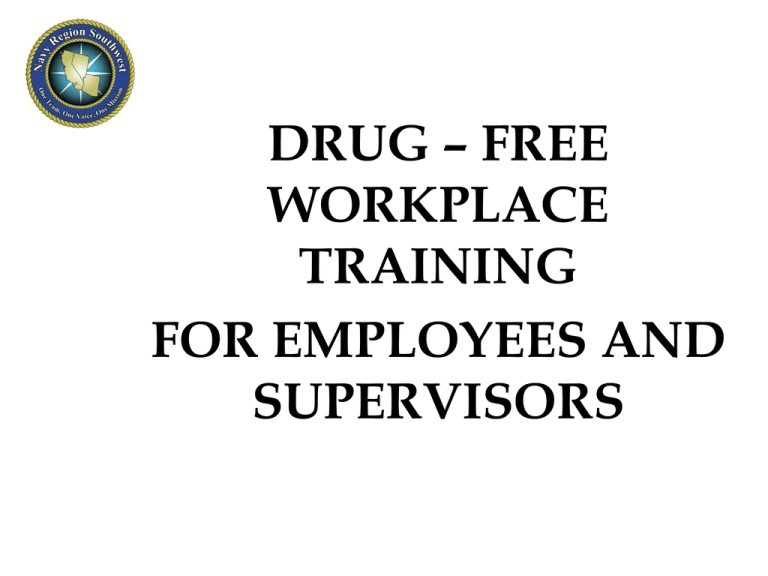
DRUG – FREE
WORKPLACE
TRAINING
FOR EMPLOYEES AND
SUPERVISORS
BACKGROUND AND IMPLEMENTING
POLICY
Executive Order 12564
signed Sept 15,1986,
• Established a goal of
achieving a drug-free
federal workplace and
made it a condition of
employment for all
federal employees to
refrain from using illegal
drugs on or off duty.
Section 503 of Public Law
100-71 was signed by
Congress July 11,1987, was
enacted to establish
uniformity among federal
agencies, require their
personal drug testing
records, ensure
confidentiality of test
results and provide
centralized program
oversight.
A Department of the Navy
Drug-Free Workplace
Program (DFWP) was
developed in compliance
with these references and
has been certified as
meeting all requirements.
Addiction (Dependence)
Addiction is a chronic,
progressive, relapsing disorder
characterized by compulsive use
of one or more substances that
result in physical, psychological,
or social harm to the individual
and continued use of the
substance or substances despite
this harm. Addiction has two
possible components, physical
dependence and psychological
dependence:
Physical Dependence- A state of becoming
physically adapted to alcohol or other drugs.
There are two important aspects to physical
dependence:
•Tolerance- the need for higher and
higher doses to achieve the same
effects.
•Withdrawal- the appearance of physical
symptoms (e.g., nausea, chills, and
vomiting) when someone stops taking a
drug too quickly.
Psychological dependence- A subjective sense
of need for alcohol or other drugs, either for
it’s positive effects or to avoid negative effects
associated with no use.
Nature of Addiction
Although addiction unquestionably begins with a
voluntary act of using a drug, continued use often
becomes involuntary, ultimately to the point that the
behavior
is driven
by a compulsive craving
Addiction
is a chronic,
progressive, relapsing disorder
characterized by compulsive use
results from
of oneThe
orcompulsion
more substances
thata number of factors, including
changes in brain function produced by prolong
resultdramatic
in physical,
psychological,
exposure to the drug
or social harm to the individual
and continued use of the
substance This
or substances
despiteis considered a brain disease. It
is why addiction
this harm.isAddiction
has twothat causes most of the problems
this compulsion
surrounding physical
addiction and what requires
possible components,
multidimensional
regimes of treatment
dependence
and psychological
dependence:
Once addicted, it is almost impossible for most people to stop
the spiraling cycle of addiction on their own without
treatment. Furthermore, addiction often becomes a chronic
recurring disorder for which repeated treatment episodes are
required before an individual achieves long-term abstinence.
Characteristics of Addiction
Addiction to alcohol or other
drugs may be:
•Chronic- Once an addiction is
developed, it will always have to be
addressed. An addict may manage to
stop using alcohol or other drugs for
significant periods of time, but the
disease typically does not disappear.
Rather it goes into remission. Should
“normal” drug use be attempted, “out
of control“ use will return rapidly..
•Progressive- Addiction gets worse
over time. With some drugs, the
decline is rapid. With others, like
alcohol, it can be more gradual.
•Primary- Addiction is not just a symptom of
some underlying psychological problem. Once
the use of alcohol or drugs becomes an
addiction, the addition itself needs to be
treated as the primary illness.
•Terminal- Addiction to alcohol or other drugs
often leads to death through damage to major
organs of the body. Also, the risk of
contraction Hepatitis C and HIV rise with use
Typical Signs of Addiction
Emotional- Aggression, anxiety, burnout, denial, depression, and
paranoia.
Behavioral- Excessive talking, impaired coordination, inability to
sit still, lack of energy, limited attention span, poor motivation,
slow reaction time, and slowed or slurred speech.
Physical- Chills, the smell of alcohol, sweating, and weight loss.
Note: while the aforementioned emotional and physical signs will likely be
present, employers and coworkers also should be cognizant of continual
missed appointments, excessive and unexplained absences or days off from
work, and repeated mistakes.
Illegal Drugs Identified by Testing
Cocaine
Cannabis
(Marijuana)
Amphetamines
Opiates
Phencyclidine
(PCP)
Ecstasy
Under the basis
of reasonable
suspicion or
after an accident
or unsafe
practice, any
employee can be
tested for other
types of drugs.
Six Types of Drug Testing
The goal of a viable Drug-Free Work Place is deterrence of illegal drug use
through a carefully controlled and monitored program of six types of drug
testing
Note: Individuals who refuse or do not show-up at the time designated for
their drug test or adulterated/substitute specimen, will be treated as a
Positive Test Result and disciplinary action will be taken.
Six Types of Drug Testing
Annually, individuals who
occupy a “Testing Designated
Positions” (TDPs) will be
randomly selected for drug
testing without prior
announcement.
Testing required of all ,
individuals tentatively
selected for employment in a
TDP. Individuals who use
illegal drugs will be screened
out during the initial
employment process before
being placed on the
employment rolls
Authorized test of any employee
involved in an on the job
accident, or who engages in
unsafe, on duty, job-related
activity. For example, an
accident which results in death
or personal injury and /or
damage to the Government or
private property. Before a test is
conducted based on an
accident or unsafe practice, it
must be approved by at least a
second level supervisor.
Random
Testing:
Applicant
Testing:
Accident or Unsafe
Practice
Testing:
Six Types of Drug Testing
Testing conducted when
management has reason to believe
that an employee may be using
illegal drugs. The suspicion must
be based on specific objective
facts, and reasonable inferences
drawn from these facts, and be
documented. Approval for such
testing must be received from a
second level supervisor or higher.
Can be based on such factors as:
observed drug use or possession,
physical evidence of an employee
being under the influence of drugs,
or evidence of tampering with a
drug test urine sample.
Reasonable
Suspicion Testing:
Testing of employees who are
not in, but who volunteer for
unannounced random testing.
Voluntary
Testing:
Testing of employees who
undergo a counseling or
rehabilitation program for illegal
drug use through the Employee
Assistance Program(EAP).
These employees are subject
to unannounced testing
following completion of such a
program for a period of one
year.
Follow-up
Testing
Deferral of Testing
•
•
•
•
•
•
A deferral of an employee’s random drug test
may be authorized by the DPC, when
requested by the employee’s first line
supervisor with higher level concurrence. The
request must be in writing and be based on a
compelling need which necessitates the
deferral on the basis that the employee is:
In a non-duty status (previously approved)
such as annual or sick leaves, suspension,
absent without leave, continuation of pay, etc.
In an official travel status away from the work
site or is about to embark on official travel
which was scheduled prior to testing
notification.
Working a different shift.
Performing a task or project that requires the
employee’s presence at the work site during
the time testing is scheduled.
Exemption- during treatment and
rehabilitation (Safe Harbor, EAP, etc.)
• The DPC will reschedule the
employee for unannounced
testing within the next 60
days.
Consequences of a Positive
Result
I should have
Listened….
Refer to
Employee
Assistance
Program (EAP)
Take
out of
TDP
May loose
security
clearance
Administer disciplinary
action:
1.First Offense anywhere
from 14-day suspension to
removal
2. Second OffenseMandatory removal;
3. Refusal of Counselingmandatory removal
4. Failure to show or Refusal
to be tested will be
considered as testing
positive.
Safe Harbor
“Safe Harbor” insulates the
employee from discipline for
admitted acts of using illegal drugs
when the agency is unaware of
such use. Under “Safe Harbor,”
management will not initiate
disciplinary action against an
employee who meets the following
three conditions:
Voluntarily
identifies
him/herself as
a user of illegal
drugs prior to
being identified
through any
other means;
Obtains
counseling and
rehabilitation
through the
EAP; and
Who is not eligible for “Safe Harbor”?
An employ who admits to illegal drug
use after being notified that he /she is
scheduled for a drug test or just after
a sample is collected, or who is found
to use illegal drugs on the basis of
other appropriate evident, e.g.,
evidence obtained from a criminal
conviction, is not eligible for “Safe
Harbor.”
Thereafter
refrains from
using illegal
drugs.
The key to the effectiveness of
“Safe Harbor” is that an employee
must be willing to admit to having
a problem and be willing to seek
help to solve the problem.
DRUG PROGRAM COORDINATOR (DPC)
For more information on a Drug
Free Workplace please contact
Mrs. Trish Petzold (760) 725-5889
Box 555020 Bldg 15100
Camp Pendleton, Ca. 92055
ROLE & RESPONSIBILITIES
Supervisors’ Role & Responsibilities
Reasonable Suspicion Drug Testing:
Take Supervisor DFWP Training
Random and Voluntary Drug Testing:
•
•
•Observe pattern of abnormal conduct or erratic
behavior.
•Discuss with Higher level authorization.
•Contact DPC to request drug testing.
Approximately 15 to 30 minutes prior to
collection, privately inform employee with the
exact time and location of test. (If more time is
required for travel to collection site, notify no
more than 60 minutes in advance.)
Explain to employee that he/she is under no
suspicion of taking drugs and that their name
was randomly selected.
•
Respond to any employee’s questions.
•
Provide “Checklist for Employees” to employee
prior to testing and instruct employee to take
appropriate photo identification.
•
Discuss with higher level supervisor of any
problem which may arise with regard to the
employee reporting for the test as scheduled. (If
a deferral is required, supervisor will furnish DPC
with required written documentation.)
•Document/maintain records.
Accident or Unsafe Practice:
•Gather information and document.
•Discuss with upper management and get approval for
testing.
•Contact DCP to initiate an accident or unsafe practice
drug test.
“Positive” Test Results
•Problem solving.
•Discuss with upper management on Disciplinary Action.
•Discuss with employee of Disciplinary Action and/or options
(EAP).
•Document/maintain records.
ROLE & RESPONSIBILITIES
Employees’ Role & Responsibilities
Refrain from illegal use of drugs on or off duty at all times.
Attend Drug Test:
•Be on time for the test and bring appropriate photo identification to test site.
•Provide urine sample when required.
•Cooperate with the MRO, to provide additional information regarding a drug test, if
necessary.
Individual with “Positive” test result:
•Has the opportunity to justify to MRO (note: if you are taking someone else’s prescription
(prescription is not in your name) this is illegal and will be considered a “Positive” test result).
•Is responsible for successful completion of any rehabilitation or treatment required as the result of
illegal use of drugs.
•Will be required follow-up testing.
Employee Assistance Program
(EAP)
The EAP plays an important role in
preventing and resolving drug abuse
problems.
EAP also provides follow-up counseling
to individuals during rehabilitation to
track their progress and encourage full
recovery.
Employees are encouraged to voluntarily
seek assistance from EAP for drug abuse
problems
The cost of actual treatment or
rehabilitation is borne by the employee
and his or her Health Benefits carrier.
EAP provides information and advice to
supervisor; addresses employees referred
to the Program who have performance4
and/or conduct problems; and makes
referrals to appropriate treatment and
rehabilitation facilities.
The EAP is administered separately from
the drug testing program and is available
to all employees without regard to a
finding of illegal drug use.
NAF EAP Service
MAGELLAN
1-800-424-5988
MagellanHealth.com/member
Exemption During Treatment and
Rehabilitation
While undergoing initial treatment or rehabilitation through the EAP, and
at the request of the EAP Administrator, the employee may be exempted
from random testing for a period not to exceed 60 days or for a time
period specified in the rehabilitation plan.
Upon completion of the stipulated exemption, the employee will be
included in a separate testing pool at the activity/command as a
part of or as follow-up to counseling or treatment for illegal drug
use for a period of 1 year, in addition to remaining in the regular
random testing pool if occupying a TDP.
QUESTIONS &
ANSWERS
Questions & Answers
Will employees know in advance of the testing?
Selection of individuals for random testing will always be unannounced. An
employee will be notified when and where to report by his or her supervisor
approximately 15 to 30 minutes before the test.
How often may an agency test any given employee?
There is no limitation on the frequency with which an employee may be tested
for illegal drug use. Under random testing, the employee will be tested whenever
the sampling method used selects the employee. In addition, the employee
could also be tested for some other reason, e.g., post accident, as determined
necessary.
What if an employee or applicant refuses to appear for a testing?
This is treated as a “Positive” test result. An employee who fails to appear for
testing without a deferral will be subject to disciplinary action. If an applicant for
employment refuses to participate in testing, the tentative offer of employment
will be canceled.
Questions & Answers
What if I can’t provide a sample?
You will be given fluids and required to remain at the testing site until you can
provide a sample. Or a physician may examine you.
What is the test like? Will the employee’s privacy be protected?
Yes. Any individual subject to testing will be permitted to provide a urine specimen
in private, in a restroom stall or similar enclosure, so that the employee is not
observed. The employee will be accompanied into the rest room by an individual of
the same sex who will wait outside the stall while the sample is being provided to
detect any attempts at adulteration.
An exception to unobserved collection will be made only where collection site
personnel have reason to believe the individual may alter or substitute the
specimen to be provided or when the basis for conducting the test is reasonable
suspicion or follow-up, as described below. In such case, collection site personnel,
of the same gender as the individual being tested, would directly observe the
employee provide the sample. A higher level supervisor shall review and concur in
advance with any decision to obtain a specimen under direct observation except in
cases of follow-up testing.
Questions & Answers
How can I be sure the test results are actually mine?
The Department of the Navy Program, as required by the Department of Health
and Human Services (DHHS), mandates a strict “chain of custody” to ensure no
specimen mix-ups. Chain of custody procedures in the Department of the Navy ‘s
testing program ensure that the urine sample taken from an employee is properly
identified and is not accidentally confused with any other sample. These
procedures apply when collecting, transferring, analyzing and storing the sample.
Each employee will be required to sign or initial the bottle used to transfer the
sample to the testing laboratory to certify that it contains his or her sample. The
bottle will then be sealed. With each subsequent transfer of possession of a
specimen, a chain of custody form will be dated, signed, and annotated as to the
purpose of the transfer. This provides for control and accountability from the point
of collection to the final disposition of the sample.
Questions & Answers
What happens if the laboratory test is Positive”?
It is important to remember that a “Positive” test result does not automatically
identify an employee or applicant as an illegal drug user. The Medical Review
Officer (MRO) will assess whether a “Positive” urine test may have resulted from
legitimate medical treatment or from some error in the chain of custody or
laboratory analysis.
What records are being kept on the testing? Will the test results be part
of an employee’s OPF?
Test results will not become a part of the employee’s OPF, but will become part of
the “Employee Medical File System of Records”. There are legal Safeguards against
inappropriate disclosure of test results.
Questions & Answers
What if an employee is found to use illegal drugs?
MCCS Camp Pendleton is committed to providing employees with drug problems
assistance in overcoming the problem. Therefore, if an employee has used illegal
drugs, he or she will be referred to the Employee Assistance Program (EAP) and
given the opportunity for counseling and rehabilitation.
Will an employee be fired for illegal drug use?
The severity of the disciplinary action taken against an employee found to use
illegal drugs will depend on the circumstances of each case and may range from 14
day suspension to removal. In any case, however, the activity must initiate
disciplinary action against any employee found to use illegal drugs except for an
employee who voluntarily admits to illegal drug use under the “safe harbor”
provision. For a second finding of illegal drug use, removal action must be initiated.
Congratulations
You have successfully completed Drug free Workplace
Click Here to Email to HR
By sending this email you are stating that you have read through the training
materials; you understand what you have read and you have addressed any
questions regarding the materials to either the Training Department or to your
Supervisor or Manager.
You must include in the body of the email:
Your Full Name
Employee ID Number
To get credit for the course








